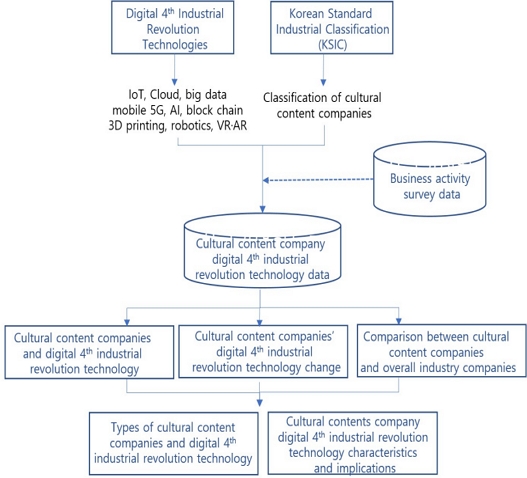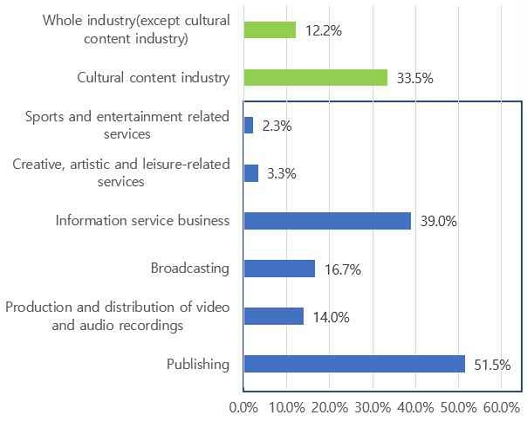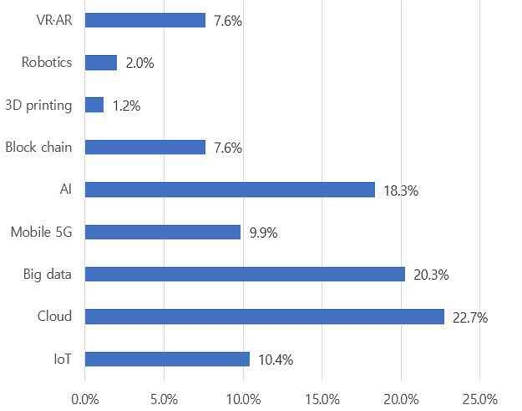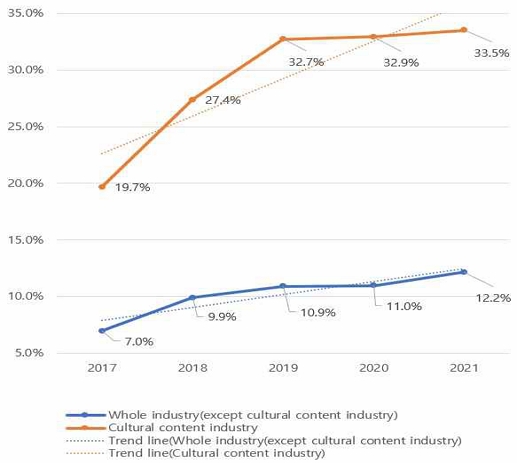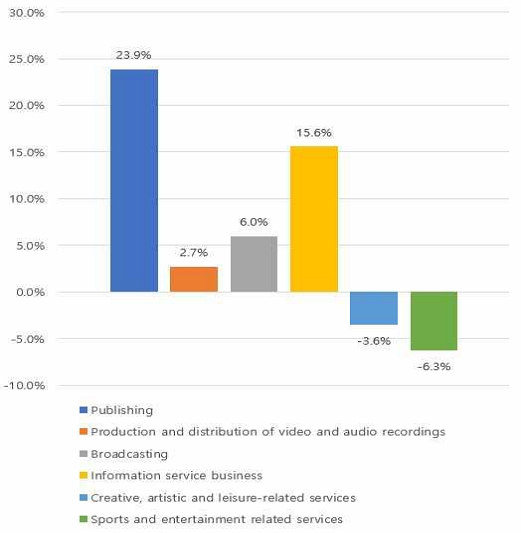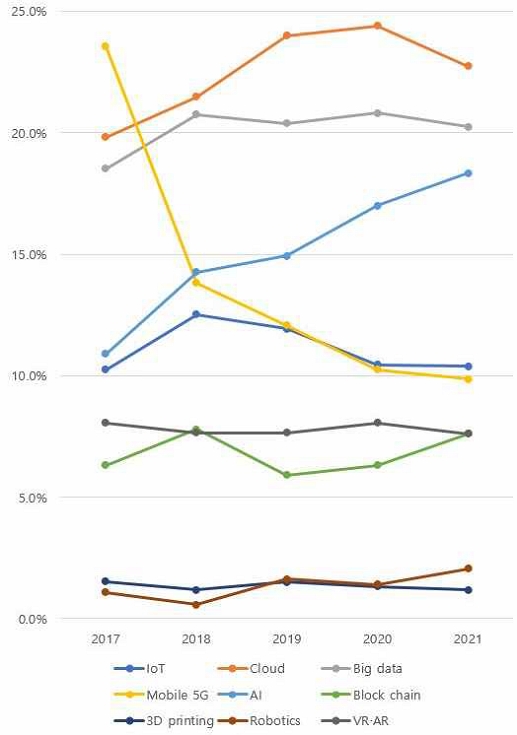
문화 콘텐츠 국내 기업의 디지털 4차 산업혁명 기술 활용 특성과 시사점
Copyright ⓒ 2023 The Digital Contents Society
This is an Open Access article distributed under the terms of the Creative Commons Attribution Non-CommercialLicense(http://creativecommons.org/licenses/by-nc/3.0/) which permits unrestricted non-commercial use, distribution, and reproduction in any medium, provided the original work is properly cited.

초록
4차 산업혁명으로 대표되는 디지털 기술은 문화 콘텐츠 산업과 기업에 큰 영향을 미칠 것으로 전망되고 있다. 본 연구는 문화 콘텐츠 기업의 4차 산업혁명 기술 활용 현황을 조사하고 이를 기반으로 문화 콘텐츠 기업의 디지털 4차 산업혁명 기술 활용 특성과 시사점을 도출하는 것이 목적이다. 이를 위해 통계청 기업활동조사 데이터에서 문화 콘텐츠 기업의 디지털 4차 산업혁명 기술 데이터를 추출하였다. 본 연구에서는 문화 콘텐츠 기업의 디지털 4차 산업혁명 기술 활용 현황을 조사하여 타 산업과 비교 분석하고 변화 추이를 조사하였다. 분석 결과를 바탕으로 문화 콘텐츠 산업의 디지털 4차 산업혁명 기술의 유형과 특성을 분석하고 시사점을 도출하였다. 연구결과 문화 콘텐츠 산업은 디지털 4차 산업혁명 기업 비율이 타 산업에 비해 높고 증가율도 타 산업에 비해 높은 것으로 나타났다. 또한 문화 콘텐츠 산업은 4차 산업혁명 기술 개발을 자체 개발하는 비중이 타 산업에 비해 높았고 세부 문화 콘텐츠 산업별 특징과 유형을 가지고 있었다. 특히 클라우드, 빅데이터, 인공지능이 핵심 3대 기술인 것으로 나타났으며, 디지털 4차 산업혁명 기술별 유형과 특징을 가지고 있어 맞춤형 전략이 필요한 것으로 분석되었다. 향후 문화 콘텐츠 기업의 특성을 반영한 디지털 4차 산업혁명 기술 지원과 문화 콘텐츠 산업의 디지털 전환에 도출된 특성과 시사점이 활용될 수 있을 것이다.
Abstract
Digital technology in the Fourth Industrial Revolution is expected to significantly impact the cultural content industry and businesses. This study aimed to investigate the current status, characteristics, and implications of digital technology utilization among cultural content companies. Data were extracted from a business activity survey conducted by the National Statistics Office of Korea. The results indicated that the ratio of digital companies in the cultural content industry was higher than that of the entire industry and the rate of increase was higher than that of the entire industry. Each specific cultural content industry had unique characteristics and types. In particular, cloud, big data, and artificial intelligence were the three core technologies. The findings indicated that a customized strategy is required based on types and characteristics of digital technology. The characteristics and implications of digital transformation of the cultural content industry and digital technology based on the characteristics of cultural content companies should be utilized in the future.
Keywords:
Fourth Industrial Revolution, Culture, Content, Digital, Technology Innovation키워드:
4차 산업혁명, 문화, 콘텐츠, 디지털, 기술 혁신Ⅰ. 서 론
문화 콘텐츠 산업은 글로벌 경제의 저성장 기조 속에서도 경쟁력과 잠재력이 높고, 콘텐츠 수출이 119억 달러(‘20)에 달하는 등 고부가가치 창출이 가능한 미래 핵심성장 동력으로 분석되고 있다[1]. 경제적 관점에서 문화 콘텐츠 산업은 취업유발계수가 18.1명(‘19년, 10억 원 당)으로 전 산업 평균 10.1명보다 높고, 부가가치 유발계수도 0.802로 전 산업 평균 0.780을 상회하는 등 고용, 부가가치, 수출 측면에서 전방과 후방 산업에 경제 효과를 견인하고 있는 중요한 산업이다[1]. 특히 영상·출판·콘텐츠, 예술·스포츠·관광 등 문화 콘텐츠 산업은 정부가 유망 서비스업으로 육성 전략을 통해 지원하고 있다[2].
4차 산업혁명으로 대표되는 디지털 기술은 문화 콘텐츠 산업과 기업에 큰 영향을 미칠 것으로 전망되고 있다. 4차 산업혁명 기술은 가상현실(VR; Virtual Reality), 증강현실(AR; Augmented Reality), 인공지능(AI; Artificial Intelligence), 빅데이터(Big Data), 클라우드(Cloud) 등으로 대표되는 디지털 기술이 대표적이다. 4차 산업혁명 관련 기술 중 가상현실과 증강현실로 대표되는 실감 기술은 문화 콘텐츠 서비스 및 미디어와 접목되어 3인칭에서 1인칭 시점을 체험할 수 있게 해 몰입감과 상호작용성을 높일 것으로 예상되고 있다[2].
영상·출판·콘텐츠 분야는 가상현실과 증강현실을 포함하는 확장현실(XR; eXtended Reality), 관광 콘텐츠 분야는 인공지능(AI) 서비스 플랫폼과 실감형 콘텐츠(AR, VR), 예술·스포츠 콘텐츠 분야는 실감형 기술(VR·AR·홀로그램)이 주요 4차 산업혁명 기술로 지적되고 있다[2].
디지털 4차 산업혁명 기술의 발전으로 향후 인공지능, 메타버스 등의 기술을 기반으로 시간과 공간에 구애받지 않는 디지털 휴먼, 가상 공연 등 새로운 문화 콘텐츠가 등장하고 다른 산업과 융합하여 새로운 신산업이 등장할 것으로 전망되고 있다[1].
향후 활성화될 디지털 전환에 따라 디지털 4차 산업혁명 기술이 문화 콘텐츠 기업에 큰 영향을 미칠 것으로 전망되는 시점에서, 디지털 4차 산업혁명 기술이 문화 콘텐츠 기업에서 활용되는 현황을 조사하고 특성을 분석해 문화 콘텐츠 기업에 디지털 4차 산업혁명 기술을 효과적으로 접목하고 지원하기 위한 시사점 도출이 필요한 상황이다. 또한 문화 콘텐츠 기업의 디지털 4차 산업혁명 기술 활용과 타 산업에서의 디지털 4차 산업혁명 기술 활용과의 차별화된 특징을 도출하고 이에 기반한 지원도 필요하다.
그러나 문화 콘텐츠 기업이 4차 산업혁명 기술을 활용하는 현황과 타 산업과 구분되는 문화 콘텐츠 기업의 4차 산업혁명 기술 활용 특성에 대한 연구는 충분하지 않은 상황이다. 문화 콘텐츠 산업이 가진 고유의 특징은 4차 산업혁명 기술의 활용에도 반영되어 차별화된 활용 특성을 가질 것으로 전망되고 이에 대한 연구가 필요하다. 또한 문화 콘텐츠 산업은 세부 산업으로 구성되어있으며, 세부 문화 콘텐츠 산업별 기업의 4차 산업혁명 기술 활용 특성에 대한 연구도 필요하다. 특히, 4차 산업혁명 기술 발전과 시간의 흐름에 따른 문화 콘텐츠 기업의 4차 산업혁명 기술 활용의 변화 특성에 대한 분석도 요구되고 있다. 향후 문화 콘텐츠 산업의 디지털 전환을 효과적으로 지원하기 위해 문화 콘텐츠 산업별 특성 및 유형과 4차 산업혁명 기술의 유형에 따른 차별화된 지원 방안에 대한 연구도 필요한 상황이다.
본 연구는 이러한 필요성을 반영하여 문화 콘텐츠 기업의 4차 산업혁명 기술 활용 현황을 조사하고 이를 기반으로 문화 콘텐츠 기업의 디지털 4차 산업혁명 기술 활용 특성과 시사점을 도출하는 것이 목적이다.
본 연구는 서론에 이어 2장 이론적 배경과 연구 프레임워크에서는 문화 콘텐츠 기업의 디지털 4차 산업혁명 기술에 대한 기존 연구를 조사하고 연구에서 활용한 연구 프레임워크를 구체화하였다. 3장 문화 콘텐츠 기업 디지털 4차 산업혁명 기술에서는 문화 콘텐츠 기업의 디지털 4차 산업혁명 기술 활용 현황을 조사하고 이를 타 산업과 비교 분석하였다. 4장 문화 콘텐츠 기업 디지털 4차 산업혁명 기술 변화에서는 디지털 4차 산업 혁명 기술 활용의 변화 추이를 분석하였다. 5장 문화 콘텐츠 기업 디지털 4차 산업혁명 기술 특성과 시사점에서는 문화 콘텐츠 세부 산업과 디지털 4차 산업혁명 기술별 유형과 특성을 분석하고 시사점을 도출하였고 6장에서는 전체 연구 결론을 제시하였다.
Ⅱ. 이론적 배경과 연구 프레임워크
2-1 이론적 배경
4차 산업혁명은 세계 경제 포럼[3],[4]에서 논의된 이후 주요 산업에 큰 영향을 미칠 것으로 전망되고 있다. 4차 산업혁명은 디지털 정보통신 기술을 활용하여 기존과 다른 비즈니스모델이 만들어지고[5] 지능화와 연결을 통해 맞춤형 혁신을 불러올 것으로 분석되고 있다[6].
디지털 4차 산업혁명 기술에 대해 4차 산업혁명의 기술 동인에 대한 연구[7]에서는 인공지능, 빅데이터, 클라우드 컴퓨팅, 사물인터넷, 로봇을 5대 핵심 4차 산업혁명 기술로 보았다. 과학기술정보통신부[8]는 4차 산업혁명 지표 관점에서 데이터, 네트워크, 인공지능을 3대 4차 산업혁명 기술로 설정하였고 특허청[9]은 4차 산업혁명 주요 기술을 인공지능, 빅데이터, 사물인터넷 디지털 건강관리, 바이오마커, 지능형 로봇, 자율주행, 3D 프린팅으로 보고 있다.
문화 콘텐츠 산업에서 4차 산업혁명 기술에 대해 여러 선행 연구가 있었다. 문화 콘텐츠 산업은 4차 산업혁명으로 인한 기술 환경의 급격한 변화에 영향을 받을 것으로 전망되고 있다[10]. 영화, 방송, 음악, 게임, 만화·애니 등 주요 문화 콘텐츠 산업별로 창작·제작, 유통, 소비·향유 단계별로 4차 산업혁명 기술이 영향을 줄 것이며 문화 콘텐츠 산업의 전통적 한계였던 성공의 불확실성을 줄이는 기반이 될 것으로 분석되었다[10]. 서비스업에 대한 한국 산업발전 비전 연구[11]에서는 콘텐츠 산업을 한국표준산업분류(KSIC) 중 출판업, 영화, 방송업으로 정의하고 4차 산업혁명과 기술 혁신의 급진전이 콘텐츠 산업에 큰 영향을 줄 것으로 보았다.
또한 콘텐츠 산업에서 빅데이터·인공지능(AI), 5G·모바일, 클라우드 컴퓨팅, VR·AR·홀로그램 기술이 다양한 관점에서 활용되고 적용될 것으로 분석되고 있다[12]. 4차 산업혁명시대 문화 콘텐츠에 대한 연구[13]에서는 4차 산업혁명 기술을 3차 산업혁명 기술의 디지털 심화로 보고 4차 산업혁명 기술은 디지털 기술 확장과 함께 지능화가 동반되며 이를 통해 사용자의 컨텍스트(Context)를 수집·파악·응용할 수 있을 것으로 전망하였다. 4차 산업혁명이 문화산업에 미치는 영향에 관한 연구[14]에서는 사물인터넷(IoT), 빅데이터, 인공지능, 클라우드 컴퓨팅을 주요 4차 산업혁명 기술로 보고, 사람, 사물, 미디어가 네트워크로 연결되는 초융합·초연결성이 문화산업에 영향을 줄 것으로 전망하였다. 4차 산업혁명시대 문화산업 경쟁력 강화방안 연구[15]에서는 사물인터넷, 인공지능, 빅데이터, 로봇, 가상현실, 드론 등을 핵심 기술로 보고 방송산업, 음악산업, 게임산업, 만화·애니메이션산업, 창작 산업의 변화를 전망하고 주요 과제를 제안하였다.
문화 콘텐츠 분야에서 4차 산업혁명 기술인 문화기술(CT)을 통한 주요 성과로 어린이용 가상현실 스포츠 플랫폼, 인공지능 가창합성 시스템, 디지털 휴먼, 홀로그램 기반 증강현실 플랫폼 기술개발, 사물인터넷 기반 유원시설 모니터링 및 체험확장 서비스 개발 등이 제시되고 있다[1].
문화 콘텐츠 산업별로도 구체적인 기술과 사례에 대한 연구도 수행되었다. 4차 산업혁명의 인문 디지털 콘텐츠에 대한 연구[16]에서는 4차 산업혁명 정보통신 기술의 융합적 접근에 기반하여 인문 디지털 콘텐츠 활성화 방안을 제시하였다. 4차 산업혁명 시대 인공지능(AI)의 작품 창작에 관한 연구[17]에서는 4차 산업혁명, 인공지능의 개념과 특징, 창작 사례를 조사하였다. 4차 산업혁명 시대 증강현실 기반 디지털 문화유산 콘텐츠 연구[18]에서는 인공지능, 증강현실/가상현실, 사물인터넷, 빅데이터, 로봇 등을 중심 4차 산업혁명 기술로 보고, 증강현실 기반의 문화예술교육을 위한 디지털 문화유산 콘텐츠에 관한 개발 사례를 제시하였다. 증강현실 얼굴인식기술을 활용한 문화 체험 콘텐츠 연구[19]에서는 4차 산업혁명 기술 중 증강현실 기술을 활용한 실감형 문화체험 콘텐츠 제작에 대해 제안하였다. 가상현실기술을 적용한 콘텐츠 개발 연구[20]에서는 4차 산업혁명의 핵심 기술을 가상현실로 보고 K-POP 콘텐츠 제작에 대한 실험 연구를 수행하였다.
살펴본 바와 같이, 문화 콘텐츠 영역에서 특정 디지털 4차 산업 혁명 기술과 활용에 관한 연구는 다수 수행되었으나 문화 콘텐츠 기업의 디지털 4차 산업 혁명 기술 전반에 관한 연구와 문화 콘텐츠 기업의 디지털 4차 산업 혁명 기술 특성과 타 산업과의 비교에 관한 연구는 다소 미흡한 실정이다. 이러한 관점에서 본 연구의 필요성이 있다고 하겠다.
2-2 연구 프레임워크
본 연구의 프레임워크는 그림 1에서 제시된 바와 같이 먼저 디지털 4차 산업혁명 기술에 관한 선행 연구와 문헌 조사를 바탕으로 주요 디지털 4차 산업혁명 기술을 도출하였다.
4차 산업혁명 기술에 대한 선행 연구에서는 이전 절에서 살펴본 바와 같이 다양한 기술들을 대상으로 하고 있다. 인공지능, 빅데이터, 클라우드 컴퓨팅, 사물인터넷, 로봇을 선정한 연구[7], 빅데이터·인공지능(AI), 5G·모바일, 클라우드 컴퓨팅, VR·AR·홀로그램 기술을 선정한 연구[12], 사물인터넷(IoT), 빅데이터, 인공지능, 클라우드 컴퓨팅을 선정한 연구[14], 사물인터넷, 인공지능, 빅데이터, 로봇, 가상현실, 드론을 선정한 연구[15], 인공지능, 증강현실/가상현실, 사물인터넷, 빅데이터, 로봇을 선정한 연구[18] 등이 있었다.
또한 4차 산업혁명 기술 기반 연구[21]에서는 4차 산업혁명 기술을 인공지능, 사물인터넷/모바일(5G), 빅데이터/클라우드, AR/VR/3D 프린팅, 블록체인, 바이오 헬스, 신소재/에너지로 보았다. 4차 산업혁명 기술에 대한 물류 연구[22]에서는 인공지능(AI), 사물인터넷(IoT), 빅데이터, 클라우드, 로봇공학, 3D 프린팅, 드론을 주요 기술로 보았다. 4차 산업혁명 기술혁신에 대한 연구[23]에서는 인공지능(AI), 사물인터넷(IoT), 클라우드, 빅데이터(Big-Data), 모바일(Mobile)을 4차 산업혁명의 핵심 주도기술로 보았다. 4차 산업혁명 시대 품질에 대한 연구[24]에서는 사물인터넷, 빅데이터, 인공지능, 로봇공학을 주요 4차 산업혁명 기반 기술로 보았다. 4차 산업혁명 기업의 R&D 역량에 대한 연구[25]에서는 사물인터넷, 인공지능, 빅데이터, 로봇, 3D 프린팅 등을 대표 기술로 보았다.
본 연구에서는 디지털 4차 산업혁명 기술을 사물인터넷 (IoT; Internet of Things), 클라우드(Cloud), 빅데이터(Big data), 모바일 5G(Mobile), 인공지능(AI; Artificial intelligence), 블록체인(Block chain), 3D 프린팅, 로봇공학(Robotics), 가상(VR)·증강현실(AR) 9가지로 통계청 기준[26]과 같이 분류하였다.
이어서 문화 콘텐츠 기업을 분류하기 위해 제10차 한국표준산업분류(KSIC)를 기초로 문화 콘텐츠 산업을 정의하였다. 본 연구에서는 문화 콘텐츠 산업을 한국표준산업분류[27] 기준 정보통신업(J) 중 출판업(58), 영상, 오디오 기록물 제작 및 배급업(59), 방송업(60), 정보서비스업(63)과 예술, 스포츠 및 여가관련 서비스업(R) 중 창작, 예술 및 여가관련 서비스업(90), 스포츠 및 오락관련 서비스업(91)으로 분류하였다.
분류된 디지털 4차 산업혁명 기술과 문화 콘텐츠 기업 분류에 따라 통계청 국가통계포털 기업활동조사[28] 데이터에서 문화 콘텐츠 기업의 디지털 4차 산업혁명 기술 데이터를 추출하였다. 추출된 데이터에 기반하여, 문화 콘텐츠 기업의 디지털 4차 산업혁명 기술 현황을 조사 및 분석하고, 이를 타 산업과 비교 분석하였다. 또한 문화 콘텐츠 기업의 디지털 4차 산업혁명 기술의 변화 추이도 함께 분석하였다.
분석 결과를 바탕으로 문화 콘텐츠 기업과 디지털 4차 산업 혁명 기술 유형을 도출하였고 문화 콘텐츠 기업의 디지털 4차 산업혁명 기술 특성과 시사점을 도출하였다.
Ⅲ. 문화 콘텐츠 기업 디지털 4차 산업혁명 기술
3-1 디지털 4차 산업혁명 기술 기업
연구 프레임워크에서 제시된 문화 콘텐츠 분류를 기준으로 문화 콘텐츠 산업 4차 산업혁명 기업 현황을 분석하였다. 분석결과 문화 콘텐츠 산업에 속한 기업 중 디지털 4차 산업혁명 관련 기술을 개발 또는 활용하는 기업의 수는 표 1에서 제시된 바와 같이 455개로 전체 기업의 33.5%를 차지하였다. 이는 전체 산업(문화 콘텐츠 산업 제외) 기업 중 4차 산업혁명 기업 비율인 12.2%보다 2.8배 높은 수준이었다. 문화 콘텐츠 기업이 타 산업 기업보다 4차 산업혁명 기술을 개발하거나 활용하는 비율이 높은 것을 보여준다.
세부 문화 콘텐츠 산업별로는 표 1과 그림 2에서 제시된 바와 같이 출판업의 디지털 4차 산업혁명 기업 비율이 51.5%로 가장 높았고 정보서비스업이 39.0%로 두 번째로 높았다. 반면에 방송업(16.7%), 영상, 오디오 기록물 제작 및 배급업(14.0%), 창작, 예술 및 여가관련 서비스업(3.3%), 스포츠 및 오락관련 서비스업(2.3%)의 디지털 4차 산업혁명 기업 비율은 낮았다.
특히, 출판업(374개)은 전체 문화 콘텐츠 산업 4차 산업혁명 기업의 82.2%로 대부분을 차지하였고 이어 정보서비스업(46개)이 10.1%로 두 개 산업이 전체의 92.3%를 차지하였다. 반면에 방송업(14개, 3.0%), 영상, 오디오 기록물 제작 및 배급업(13개, 2.9%), 스포츠 및 오락관련 서비스업(7개, 1.5%), 창작, 예술 및 여가관련 서비스업(1개, 0.2%)의 비중은 상대적으로 낮았다.
3-2 디지털 4차 산업혁명 기술 개발 활용
문화 콘텐츠 기업이 개발 또는 활용하는 디지털 4차 산업혁명 기술은 표 2와 그림 3과 같이 분석되었다. 문화 콘텐츠 기업이 개발 또는 활용하는 비중이 높은 4차 산업혁명 기술은 클라우드(22.7%), 빅데이터(20.3%), 인공지능(18.3%)으로 세 기술이 전체의 61.3%를 차지하였다. 이에 반해 사물인터넷(10.4%), 모바일 5G(9.9%), 블록체인(7.6%), 로봇공학(2.0%), 3D 프린팅(1.2%)의 비중은 상대적으로 낮았다.

Ratio of development and utilization of digital 4th industrial revolution technology in the cultural contents industry (2021)
문화 콘텐츠 산업과 전체 산업(문화 콘텐츠 산업 제외)의 4차 산업혁명 기술 활용 비중 차이를 비교하면, 인공지능 비중이 문화 콘텐츠 산업이 18.3%, 타 산업이 12.9%로 문화 콘텐츠 산업에서 상대적으로 5.5% 비중이 높았고 블록체인도 4.7% 비중이 높았다. 반면에 로봇공학(-6.0%), 3D 프린팅(-5.1%), 사물인터넷(-3.8%)은 타 산업에 비해 문화 콘텐츠 산업에서 비중이 상대적으로 낮았다.
3-3 디지털 4차 산업혁명 기술 활용 분야
문화 콘텐츠 산업의 디지털 4차 산업혁명 기술 활용 분야는 표 3에서 제시된 바와 같이 제품(서비스) 개발 분야가 전체의 74.9%를 차지하였고 이어서, 판매목적(13.6%), 마케팅전략(7.6%) 순이었다. 상대적으로 조직관리(2.1%)와 생산공정(1.7%)의 비중은 낮았다. 타 산업에서 4차 산업혁명 기술 활용 분야와 비교하면, 문화 콘텐츠 산업은 제품(서비스) 개발 분야의 비중이 타 산업에 비해 32.2% 높은 반면, 생산공정(-17.5%), 조직관리(-10.6%), 마케팅 전략(-3.6%), 판매목적(-0.4%)의 상대 비중은 낮았다.
3-4 디지털 4차 산업혁명 기술 개발 방법
문화 콘텐츠 산업에서 디지털 4차 산업혁명 기술을 개발하는 방법은 표 3에서 제시된 바와 같이 자체 개발이 84.8%, 국내 위탁 개발이 13.3%, 국외 위탁 개발이 2.0%를 차지하였다. 타 산업과 비교하면, 문화 콘텐츠 산업은 자체 개발의 비중이 20.6% 높았고, 국내 위탁 개발(-18.8%)과 국외 위탁 개발(-1.8%)의 비중은 상대적으로 낮았다.
세부 문화 콘텐츠 산업별로는 특히 스포츠 및 오락관련 서비스업은 국내 위탁 개발 비중이 85.7%로 자체 개발 14.3%에 비해 높은 비중을 보였다. 또한 방송업의 경우 국내 위탁 개발 비중이 38.9%로 문화 콘텐츠 산업 평균 13.3%보다 상대적으로 높은 비중을 보였다.
Ⅳ. 문화 콘텐츠 기업 디지털 4차 산업혁명 기술 변화
4-1 디지털 4차 산업혁명 기술 기업 변화
문화 콘텐츠 산업의 디지털 4차 산업혁명 기술 활용 또는 개발 기업의 비율은 표 4와 그림 4에서 제시된 바와 같이 2017년 19.7%에서 2021년 33.5%로 13.8% 증가하였다. 반면에 같은 기간 전체 산업(문화 콘텐츠 산업 제외)에서 디지털 4차 산업혁명 기업 비율은 7.0%에서 12.2%로 5.2% 증가하였다. 문화 콘텐츠 산업의 디지털 4차 산업혁명 기업 증가율이 타 산업에 비해 높아, 문화 콘텐츠 산업과 타 산업간 차이가 2017년 12.7%에서 2021년 21.4%로 확대되는 추세를 보이고 있다.
4-2 문화 콘텐츠 산업별 변화
세부 문화 콘텐츠 산업별로는 표 4와 그림 5에서 제시된 바와 같이 출판업이 2017년 27.6%에서 2021년 51.5%로 23.9% 증가해 가장 높은 증가율을 보였고, 이어서 정보서비스업이 2017년 23.4%에서 2021년 39.0%로 15.6% 증가하였다. 방송업이 6.0%, 영상, 오디오 기록물 제작 및 배급업이 2.7%로 완만히 증가하였으나, 스포츠 및 오락관련 서비스업(-6.3%)과 창작, 예술 및 여가관련 서비스업(-3.6%)은 디지털 4차 산업혁명 기술 기업 비율이 감소 추세를 보였다.
4-3 디지털 4차 산업혁명 기술 변화
문화 콘텐츠 산업 디지털 4차 산업혁명 기술 개발 또는 활용 기술의 비중은 표 5와 그림 6에서 제시된 바와 같이 2017년 모바일 5G가 23.5%로 가장 높았으나, 2021년 9.9%로 13.7% 감소하여 5번째 비중을 차지하는 것에 그쳤다. 반면에 인공지능은 2017년 10.9%에서 2021년 18.3%로 7.4% 증가하여 가장 높은 비중 증가세를 보였다. 클라우드와 빅데이터는 2017년 각각 두 번째와 세 번째 비중을 가지고 있었으나 2.9%, 1.7% 비율이 증가하여 문화 콘텐츠 산업에서 가장 비중이 높은 2대 디지털 4차 산업혁명 기술이 되었다. 사물인터넷(0.2% 증가)과 블록체인(1.3% 증가)은 비중이 완만히 증가하였고, 가상·증강현실(0.5% 감소)은 비중이 축소되었다.

Cultural content industry digital 4th industrial revolution development and utilization technology change (2017-2021)
4-4 디지털 4차 산업혁명 기술 활용 분야 변화
문화 콘텐츠 산업 디지털 4차 산업혁명 기술 활용 분야에서 증가율이 가장 높은 분야는 표 6에서 제시된 바와 같이 판매목적이었다. 판매목적으로 디지털 4차 산업혁명 기술을 활용한 비중이 2018년 9.3%에서 2021년 13.6%로 4.3% 증가하였다. 반면에 마케팅 전략에서는 2018년 12.1%에서 2021년 7.6%로 비중이 4.5% 감소하였다. 제품(서비스) 개발은 2018년에 비해 2021년 1.0% 비중이 증가하였고, 조직관리는 같은 기간 0.7% 비중이 감소하였다.
Ⅴ. 문화 콘텐츠 기업 디지털 4차 산업혁명 기술 특성과 시사점
5-1 문화 콘텐츠 산업 유형
본 연구에서는 문화 콘텐츠 기업의 디지털 4차 산업혁명 기술 혁신 특성을 분석하기 위하여 문화 콘텐츠 산업 디지털 4차 산업혁명 기업 비율(Y축)과 디지털 4차 산업혁명 기업 비율의 증가율(X축)을 축으로 그림 7과 같이 문화 콘텐츠 산업의 디지털 4차 산업혁명 혁신 유형을 분류하였다. 전체 산업(문화 콘텐츠 산업 제외)의 디지털 4차 산업혁명 기업 비율 평균 12.2%를 초과하는 문화 콘텐츠 세부 산업은 출판업(51.5%), 정보서비스업(39.0%), 방송업(16.7%), 영상, 오디오 기록물 제작 및 배급업(14.0%)이었다.
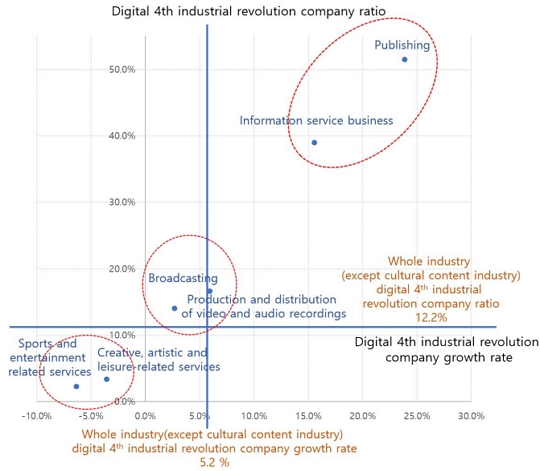
Cultural contents industry digital 4th industrial revolution types of innovation based on ratio and growth rate
전체 산업(문화 콘텐츠 산업 제외)의 디지털 4차 산업혁명 기업 비율 증가율 평균 5.2%를 초과한 문화 콘텐츠 산업은 출판업(23.9%)과 정보서비스업(15.6%)이었고 나머지 문화 콘텐츠 산업은 타 산업의 증가율과 동등 수준이거나 이하였다.
문화 콘텐츠 산업의 디지털 4차 산업혁명 혁신 유형 분류 기준에 따라 I 사분면(디지털 4차 산업혁명 기업 비율도 높고 디지털 4차 산업혁명 기업 증가율도 높은 산업)에 해당하는 문화 콘텐츠 산업은 출판업과 정보서비스업이었다. 출판업과 정보서비스업은 디지털 4차 산업혁명 기술 활용 기업 비율도 높고 디지털 4차 산업혁명 기술 활용 기업 증가율도 높아 디지털 4차 산업혁명 기술 활용 및 개발이 가장 활발한 문화 콘텐츠 산업으로 분석되었다.
II 사분면(디지털 4차 산업혁명 기업 비율은 높으나 4차 산업혁명 기업 증가율은 낮은 산업)에 속하는 문화 콘텐츠 산업은 방송업과 영상, 오디오 기록물 제작 및 배급업이었다. 두 산업은 현재는 디지털 4차 산업혁명 기술 활용이 평균 이상이나 증가율이 타 산업 평균에 비해 낮아, 현 추세가 유지될 경우 디지털 4차 산업혁명 기술 개발 또는 활용 기업 비율이 평균보다 낮아질 것으로 전망된다.
III 사분면(디지털 4차 산업혁명 기업 비율이 낮고 4차 산업혁명 기업 증가율도 낮은 산업)에 해당하는 문화 콘텐츠 산업은 창작, 예술 및 여가관련 서비스업과 스포츠 및 오락관련 서비스업이었다. 두 산업은 디지털 4차 산업혁명 관련 기업 비율과 증가율이 타 산업에 비해 모두 낮아 디지털 4차 산업혁명 기술 관련 혁신이 상대적으로 활발하지 못한 산업으로 분석되었다. 문화 콘텐츠 산업에서는 IV 사분면에 해당하는 산업은 존재하지 않았다.
5-2 디지털 4차 산업혁명 기술 유형
문화 콘텐츠 산업에서 개발 또는 활용되는 디지털 4차 산업혁명 기술의 특성을 분석하기 위하여 디지털 4차 산업혁명 기술 비중(Y축)과 디지털 4차 산업혁명 기술 비중 증가율(X축)을 축으로 그림 8과 같이 디지털 4차 산업혁명 기술 혁신 유형을 구분하였다. 본 연구에서 활용한 9개 디지털 4차 산업혁명 기술의 비중 평균인 11.1%를 초과하는 디지털 4차 산업혁명 기술은 클라우드(22.7%), 빅데이터(20.3%), 인공지능(18.3%) 이었고 나머지 기술은 평균을 하회하였다.
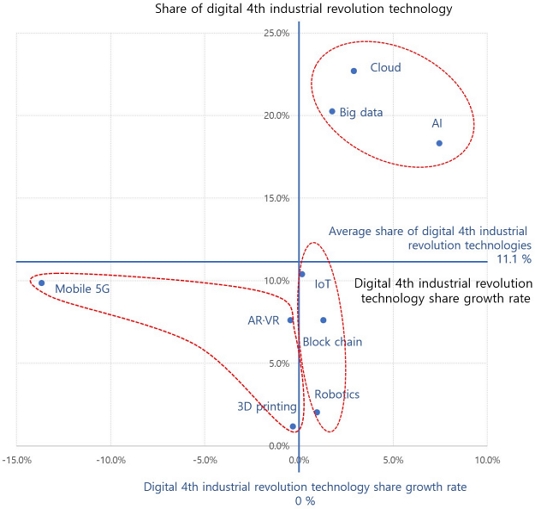
Cultural contents industry digital 4th industrial revolution technology types of innovation based on share and growth rate
디지털 4차 산업혁명 기술 비중 증가가 양(+)의 증가율을 보인 디지털 4차 산업혁명 기술은 인공지능(7.4%), 클라우드(2.9%), 빅데이터(1.7%), 블록체인(1.3%), 로봇공학(0.9%), 사물인터넷(0.2%) 이었다. 나머지 기술은 디지털 4차 산업혁명 기술 비중 증가가 음(-)의 증가율을 보였다.
디지털 4차 산업혁명 기술 혁신 유형 분류 기준에 따라 I 사분면(디지털 4차 산업혁명 기술 비중도 높고 디지털 4차 산업혁명 기술 비중 증가율이 양(+)의 증가율인 기술)에 해당하는 기술은 클라우드, 인공지능, 빅데이터였다. 해당 디지털 4차 산업혁명 기술이 문화 콘텐츠 산업에서 차지하는 비중과 비중의 증가율이 모두 높아, 문화 콘텐츠 산업에서 가장 중요한 4차 산업혁명 기술로 분석되었다.
II 사분면에 해당하는 디지털 4차 산업혁명 기술은 존재하지 않았고, III 사분면(디지털 4차 산업혁명 기술 비중도 낮고 비중 증가율이 음(-)인 기술)에 해당하는 기술은 모바일 5G, 가상·증강현실, 3D 프린팅이었다. 해당 디지털 4차 산업혁명 기술은 문화 콘텐츠 산업에서 차지하는 비중이 낮고 증가율도 감소하는 추세로 문화 콘텐츠 산업에서 상대적인 중요도가 낮은 기술로 조사되었다.
IV 사분면(디지털 4차 산업혁명 기술 비중은 낮으나 비중 증가율이 양(+)인 기술)에 해당하는 기술은 사물인터넷, 블록체인, 로봇공학이었다. 해당 기술은 비중은 상대적으로 낮으나, 비중 증가율이 양(+)의 증가 추세를 가지고 있어 I 사분면에 해당하는 기술에 이어 중요도가 높은 기술로 분석되었다.
5-3 문화 콘텐츠 기업 디지털 4차 산업혁명 기술 특성과 시사점
본 연구에서는 조사·분석 및 연구 결과에 기반하여 디지털 4차 산업혁명과 문화 서비스산업 기술 혁신에 대해 표 7과 같이 특성과 시사점을 도출하였다.

Cultural contents company digital 4th industrial revolution technology characteristics and implications
첫째, 문화 콘텐츠 산업은 디지털 4차 산업혁명 기업 비율(33.5%)이 타 산업(12.2%)에 비해 2.8배 높아 디지털 4차 산업혁명 기술의 개발 및 활용 기업 비율이 높은 것으로 분석되었다. 특히 최근 5년간 문화 콘텐츠 산업의 디지털 4차 산업혁명 기업 비율 증가율이 타 산업에 비해 높아, 격차(2017(12.7%)→ 2021(21.4%))가 확대되고 있다. 현 추세가 유지될 경우 향후 문화 콘텐츠 산업의 디지털 4차 산업혁명 기업 비율이 타 산업에 비해 더욱 확대될 것으로 전망된다.
둘째, 문화 콘텐츠 산업의 디지털 4차 산업혁명 기술 활용 분야는 제품(서비스) 개발과 판매목적이 전체의 89%를 차지하고 있으나, 타 산업에서는 제품(서비스) 개발 비중(42.7%)이 문화 콘텐츠 산업에 비해 32.2% 낮아, 문화 콘텐츠 산업은 타 산업과 디지털 4차 산업혁명 기술 활용 분야가 상이하였다. 특히 최근 5년간 문화 콘텐츠 산업에서 판매목적 비중이 증가(+4.3%)한 반면, 마케팅 전략 비중은 축소(-4.5%)되었다. 향후 문화 콘텐츠 산업의 제품(서비스) 개발과 판매목적 관련 디지털 4차 산업혁명 기술 지원이 필요하다.
셋째, 문화 콘텐츠 산업의 디지털 4차 산업혁명 기술 개발 방법은 자체 개발(84.8%) 비중이 타 산업에 비해 높고(+20.6%), 국내 위탁 개발 비중은 낮은(-18.8%) 것으로 조사되었다. 문화 콘텐츠 산업의 특성을 반영하여 자체 개발 역량 강화 및 국내 위탁 개발 지원이 필요하다.
넷째, 문화 콘텐츠 산업 유형 분석 결과 세부 문화 콘텐츠 산업별 특징을 가지고 있었다. 출판업과 정보서비스업은 디지털 4차 산업혁명 기업 비율과 디지털 4차 산업혁명 기업 비중 증가율이 모두 높은 산업이었다. 방송업과 영상, 오디오 기록물 제작 및 배급업은 디지털 4차 산업혁명 기업 비율은 높으나 디지털 4차 산업혁명 기업 증가율은 낮은 산업으로 조사되었다. 창작 예술 및 여가관련 서비스업과 스포츠 및 오락관련 서비스업은 디지털 4차 산업혁명 기업 비율이 낮고 디지털 4차 산업혁명 기업 증가율도 낮은 산업으로 분석되었다. 세부 산업별 특성을 반영하여, 문화 콘텐츠 산업별 디지털 4차 산업혁명 혁신유형에 따른 디지털 4차 산업혁명 기업 비율 및 증가율 상향을 위한 산업별 맞춤형 전략이 요구된다.
다섯째, 문화 콘텐츠 산업의 디지털 4차 산업혁명 기술은 클라우드(22.7%), 빅데이터(20.3%), 인공지능(18.3%) 세 기술이 전체의 61.3%를 차지하였고, 최근 5년간 인공지능의 비중은 증가(+7.4%)한 반면 모바일 5G는 감소(-13.7%)하였다. 문화 콘텐츠 산업에서는 클라우드, 빅데이터, 인공지능 3개 디지털 4차 산업혁명 기술이 중요하며, 향후 핵심 3대 디지털 4차 산업혁명 기술 지원이 필요하다.
여섯째, 디지털 4차 산업혁명 기술별 유형 분석 결과 세부 기술별 특징을 가지고 있었다. 클라우드, 인공지능, 빅데이터는 문화 콘텐츠 산업 4차 산업혁명 기술 비중도 높고, 비중 증가율도 양(+)인 기술로, 3대 기술(클라우드, 인공지능, 빅데이터)이 문화 콘텐츠 산업의 4차 산업혁명 핵심 기술로 분석되었다. 이에 반해 모바일 5G, 가상·증강현실, 3D 프린팅은 디지털 4차 산업혁명 기술 비중도 낮고 비중 증가율이 음(-)인 기술로 상대적으로 중요도가 낮은 기술로 조사되었다. 또한 사물인터넷, 블록체인, 로봇공학은 디지털 4차 산업혁명 기술 비중은 낮으나 비중 증가율이 양(+)인 기술로 나타났다. 이러한 기술별 유형 특성을 반영하여 디지털 4차 산업혁명 기술별 유형에 따른 기술 비중 및 증가율 확대를 위한 맞춤형 전략이 필요하다.
ⅤI. 결 론
본 연구에서는 4차 산업혁명 시대를 맞아 디지털 전환이 가속화되는 시점에서 중요성이 커지고 있는 디지털 4차 산업혁명 기술에 대해 문화 콘텐츠 기업의 디지털 4차 산업혁명 기술 활용 현황을 조사하고 타 산업과 비교 분석하였다. 변화하는 디지털 4차 산업혁명 기술의 문화 콘텐츠 기업 접목을 분석하기 위하여 변화 추이를 조사하였다. 분석 결과를 바탕으로 문화 콘텐츠 세부 산업과 디지털 4차 산업혁명 기술별 유형과 특성을 분석하고 시사점을 도출하였다.
연구결과 문화 콘텐츠 산업은 디지털 4차 산업혁명 기업 비율이 타 산업에 비해 높고 증가율도 타 산업에 비해 높은 것으로 분석되었고, 문화 콘텐츠 산업은 4차 산업혁명 기술을 제품(서비스) 개발과 판매에 주로 활용하여 타 산업과 기술 활용 분야가 상이하였다. 또한 문화 콘텐츠 산업은 4차 산업혁명 기술을 자체 개발하는 비중이 타 산업에 비해 높았고 세부 문화 콘텐츠 산업별 특징과 유형을 가지고 있었다. 특히 문화 콘텐츠 산업의 디지털 4차 산업혁명 기술은 클라우드, 빅데이터, 인공지능이 핵심 3대 기술인 것으로 나타났으며, 디지털 4차 산업혁명 기술별 유형과 특징을 가지고 있어 맞춤형 전략이 필요한 것으로 분석되었다.
본 연구는 문화 콘텐츠 기업이 4차 산업혁명 기술을 활용하는 현황과 타 산업과 구분되는 문화 콘텐츠 기업의 4차 산업혁명 기술 활용 특성을 도출하였다. 특히 기술 발전에 따라 변화하는 문화 콘텐츠 산업의 4차 산업혁명 기술 특성에 대해 분석하였고, 문화 콘텐츠 세부 산업과 4차 산업혁명 기술에 대한 유형과 특성 및 시사점을 도출하였다. 향후 문화 콘텐츠 기업의 특성을 반영한 디지털 4차 산업혁명 기술 지원과 문화 콘텐츠 산업의 디지털 전환에 도출된 특성과 시사점이 활용될 수 있을 것이다.
본 연구는 디지털 4차 산업혁명 관련 9개 기술을 본 연구의 분석대상으로 하였으나, 문화 콘텐츠 산업에서 활용될 수 있는 기술의 범위는 확대되는 추세이다. 향후 본 연구에서 분석대상에 포함되지 않은 디지털 4차 산업혁명 기술에 관해서 추가적인 연구가 필요하다고 하겠다.
References
- Ministry of Culture, Sports and Tourism, Summary of the 4th Cultural Technology Research and Development (R&D) Basic Plan, 2022.
- Ministry of Strategy and Finance, Service Industry COVID-19 Response and Development Strategy, 2021.
- K. Schwab, The Fourth Industrial Revolution, Geneva: World Economic Forum, 2016.
- K. Schwab, The Fourth Industrial Revolution: What It Means and How to Respond, Foreign Affairs, 2015.
-
D. H. Byun, “Survey of Service Industry Policy and Big Data Analysis of Core Technology in Preparation of the Fourth Industrial Revolution,” Journal of Service Research and Studies, Vol. 8, No. 1, pp. 73-87, March 2018.
[https://doi.org/10.18807/jsrs.2018.8.1.073]

- N. H. Kim, “The 4th Industrial Revolution and Service Industry Development Strategy,” Hana Finance Focus, Vol. 6, No. 35, pp. 1-3, 2016.
- S. K. Kim, B. S. Choi, H. T. Yang, P. S. Jang, S. J. Sohn, P. Y. Jang, ... and S. S. Song, Technological Drivers and Industrial Impacts of the Fourth Industrial Revolution, STEPI, 2017.
- Ministry of Science and ICT, 2021 Fourth Industrial Revolution Indicators, 2021.
- Korean Intellectual Property Office, Convergence Technology Patents Increased 22 Times Over 10 Years, 2022.
- Korea Management Association Consulting, 3rd Cultural Technology R&D Master Plan Establishment Study, Korea Creative Content Agency, 2018.
- KIET, Korean Industrial Development Vision 2030: Volume 3 Service Industry, 2019.
- KIET, A Study on the Mid- to Long-term Roadmap for the Development of the Service Industry from the Perspective of Business Model Innovation: Volume 2 Service Industry, 2020.
-
K. D. Kim, “Contents and Cultural Contents in the 4th Industrial Revolution Age,” Humanities Content Journal of Digital Contents Society, Vol. 52, No. 2, pp. 9-31, March 2019.
[https://doi.org/10.18658/humancon.2019.03.52.9]

- J. W. Byun, “A Study of The 4th Industrial Revolution’s Impact on Cultural Industry,” Journal of Culture Industry, Vol. 17, No. 3, pp. 109-118, September 2017.
-
J. S. Park, “A Plan Strengthen the Competitiveness of the Cultural Industry in the era 4th Industrial Revolution,” Journal of Culture Industry, Vol. 19, No. 4, pp. 35-41, December 2019.
[https://doi.org/10.35174/JKCI.2019.12.19.4.35]

-
H. J. Choi and J. H. Lee, “Humanities Digital Contents of the Fourth Industrial Revolution,” Journal of Digital Contents Society, Vol. 19, No. 6, pp. 1097-1103, June 2018.
[https://doi.org/10.9728/dcs.2018.19.6.1097]

-
M. S. Kang and J. W. Joo, “A Study on the Creation of Artificial Intelligence(AI) in the Fourth Industrial Revolution,” Journal of Digital Contents Society, Vol. 21, No. 1, pp. 121-130, January 2020.
[https://doi.org/10.9728/dcs.2020.21.1.121]

-
J. Y. Chun, “A Study on Digital Heritage Content Development for Augmented Reality based Culture and Arts Education in the Fourth Industrial Revolution,” Journal of Digital Contents Society, Vol. 20, No. 12, pp. 2357-2366, December 2019.
[https://doi.org/10.9728/dcs.2019.20.12.2357]

-
T. H. Kim, “Content Design and Production for Experiencing Korean, Chinese and Japanese Traditional Masks using AR Face Recognition Technology,” Journal of Digital Contents Society, Vol. 23, No. 12, pp. 2355-2364, December 2022.
[https://doi.org/10.9728/dcs.2022.23.12.2355]

-
T. E. Kim, “Development of Retro Content Using Virtual Reality Technology,” Journal of Digital Contents Society, Vol. 22, No. 4, pp. 579-585, April 2021.
[https://doi.org/10.9728/dcs.2021.22.4.579]

-
S. S. Lee and J. E. Lee, “Mediating Effect of Entrepreneurship Between Government R&D Support and Performance of Technological Innovation for Venture Companies based on 4th Industrial Revolution Technology,” Journal of the Korean Entrepreneurship Society, Vol. 17, No. 5, pp. 149-176, October 2022.
[https://doi.org/10.24878/tkes.2022.17.5.149]

- A. Y. Kim, Y. S. Choi, and S. G. Kim, “A Study on the Application of the Fourth Industrial Revolution Technology,” Journal of Shipping and Logistics, Vol. 36, No. 4, pp. 577-596, December 2020.
-
Y. D. Yoon, “Technology Innovation, Decentralization and Creativity in the Era of the 4th Industrial Revolution,” Journal of Culture Industry, Vol. 20, No. 3, pp. 23-33, September 2020.
[https://doi.org/10.35174/JKCI.2020.09.20.3.23]

-
J. W. Baik, “Quality Management Direction in the 4th Industrial Revolution Era,” Industry Promotion Research, Vol. 5, No. 4, pp. 1-13, October 2020.
[https://doi.org/10.21186/IPR.2020.5.4.001]

-
S. J. Yoon and J. H. Seo, “The Effect of Fourth Industrial Revolution Companies’ R&D Capabilities on Their Innovation Performance,” Journal of Korea Technology Innovation, Vol. 25, No. 4, pp. 627-660, August 2022.
[https://doi.org/10.35978/jktis.2022.8.25.4.627]

- Statistics Korea, Glossary of Business Activity Survey Results, 2020.
- Statistics Korea, 10th Korea Standard Industrial Classification, 2017.
- Statistics Korea, Korean Statistical Information Service(KOSIS, https://kosis.kr, ), Business Activity Survey, 2023.
저자소개

1996년:포항공과대학교(공학사-산업공학)
1998년:포항공과대학교 대학원(공학석사-산업공학)
2002년:포항공과대학교 대학원(공학박사-산업공학)
2002년~2005년: LG CNS
2005년~2022년: 과학기술정책연구원
2022년~현 재: 계명대학교 산업공학과 교수
※관심분야:서비스 혁신, 스마트제조 혁신, 기술 혁신, 4차 산업혁명, 문화 콘텐츠, 디지털 전환 등
